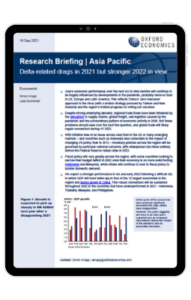APAC: Delta-related drags in 2021 but stronger 2022 in view

Asia’s economic performance over the next six to nine months will continue to be hugely influenced by developments in the pandemic, probably more so than in US, Europe and Latin America. This reflects China’s ‘zero tolerance’ approach to the virus (with a similar strategy pursued by Taiwan and New Zealand) and the region’s limited progress on rolling out vaccines.
What you will learn from this report:
- Despite strong underlying demand, regional trade flows have been hindered by the disruption to supply chains, global freight, and logistics caused by the pandemic and the extraordinary pattern of economic activity in 2020. But these problems should ease over the next few quarters, and global trade will likely regain momentum during H1 2022.
- With inflation less of an issue across Asia than in the US or many emerging markets – and countries such as Indonesia less vulnerable to the impact of changing US policy than in 2013 – monetary policies across the region will be governed by particular national concerns, with widespread rate hikes unlikely before the Federal Reserve raises rates in 2023.
- Fiscal policy will vary greatly across the region, with some countries looking to narrow their budget deficit in 2022 once their economy is on more solid footing (Indonesia and Malaysia), while others will continue to look to fiscal policy to bolster domestic demand.
- We expect a stronger performance in Q4 and early 2022 following a difficult Q3, in which GDP will have fallen q/q in four of the 12 largest economies in the region and barely grown in China. This robust momentum will be sustained throughout 2022 in the countries that have underperformed in 2021 – Indonesia, Thailand, Malaysia, and Philippines.
Tags:
Related Services

Post
Demographics are set to propel niche property types in the UK
As the UK population ages, time-use data suggest that the property sectors with structural tailwinds will be those that provide space for activities related to home entertainment, eating and drinking, socialising, events, leisure, hobbies, and sports/exercise.
Find Out More
Post
UK : The everyday economy matters to local economic performance
The everyday economy generates half of all UK employment and 33% of GVA but is often dismissed because it generates less growth than high value services and has low productivity. But indirectly it has the capacity to improve the competitiveness and performance of local economies and has been identified by Labour Party leaders as a sector to focus on, if they win the election.
Find Out More